Welcome
to the McGill Bird Observatory weekly report.
Click here for a complete listing of our archives.
Comments or
questions are welcome at "mbo AT migrationresearch.org".
|
PICTURE
OF THE WEEK: |
|
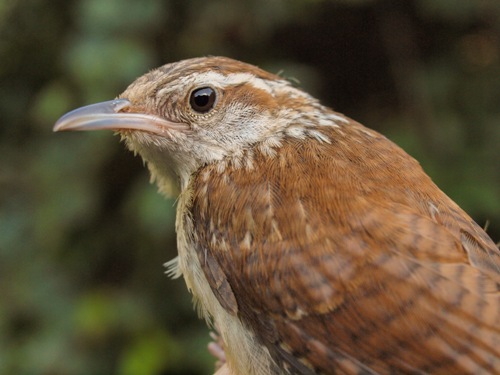
A great surprise to kick off the season - MBO's first ever Carolina Wren was banded
on the third day of the season. It was a juvenile - are its parents nearby too? We
have now banded 113 species at MBO since our start in 2004.
(Photo by Simon Duval)
-
|
|
|
THIS WEEK |
THIS FALL |
2013 TOTAL |
SITE TOTAL |
|
# birds (and species) banded |
300 (41) |
300 (41) |
1595 (80) |
43107 (113) |
|
# birds (and species) repeat |
67 (16) |
67 (16) |
397 (40) |
8378 (70) |
|
# birds (and species) return |
7 (5) |
7 (5) |
162 (29) |
1371 (38) |
|
# species observed |
84 |
84 |
153 |
208 |
|
# net hours |
560.0 |
560.0 |
3916.8 |
73206.5 |
|
# birds banded / 100 net hours |
53.4 |
53.4 |
40.7 |
58.9 |
|
|
Note: table does not include nocturnal banding (owls) |
|
Banders-in-charge: Simon Duval, Gay Gruner
Assistants: Nicolas Bernier, Marie-France Boudreault, Rui de Jesus, Jean Demers, Jo-Annie Gagnon, Nathalie Gendron, Alison Hackney, Lisa Keelty, Barbara MacDuff, Charlotte Payette, Catherine Russell, Joanne Ryan, Clémence Soulard, Elise Titman, Rodger Titman
Notes: Fall migration is off to another great start! While it seems like mid-summer to most people, the birds know otherwise. Remarkably, for a fourth year in a row we set a new record for the number of birds banded in the first week of August, with an even 300 - a modest jump from last year's 281, and a fair bit above the 257 in 2011 and 250 in 2010. A good number of them also stuck around for at least a couple of days, with the 67 repeats this week a substantial jump from the previous record of 50. As per tradition, the first day was the busiest, with 70 birds banded. However, it was quite busy most of the week, with between 39 and 55 daily except for a bit of a lull on August 5 with just 21 new birds that day - but that provided a good opportunity for the crew to do some much needed site maintenance (and to spot a Cooper's Hawk carrying prey toward the Arboretum). There was a lot of variety too, with 41 species banded this week - two more than the previous high for week 1. Even more surprisingly, the 84 species observed this week was a new record by 9, providing ample evidence that migration is well underway already. New observations for the year were Black-crowned Night Heron, Spotted Sandpiper, and Bank Swallow.
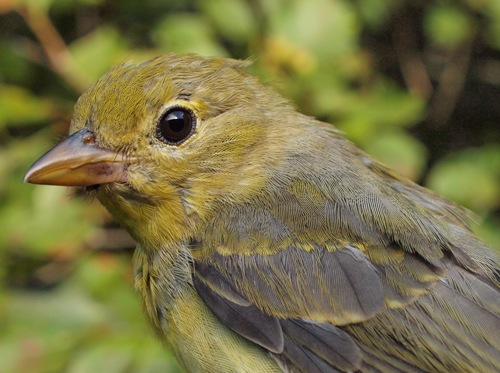
One of the early surprises this week was the juvenile Scarlet Tanager above, a species that more commonly passes through MBO later in August. Meanwhile, the Northern Parula below is likely one of the season's first moult migrants to arrive at MBO. These two species, along with Indigo Bunting, were all banded this week for the first time in 2013.
(Photos by Simon Duval)
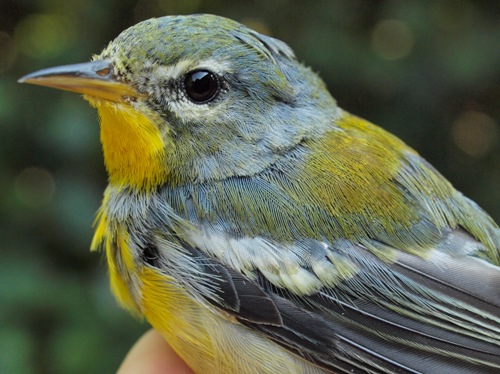 |
Moult migration is a phenomenon that is relatively poorly documented in eastern North America, but which is quite evident at MBO each fall. These are birds that breed somewhere to the north (presumably) and settle at MBO during their moult, which is often a period of 3-4 weeks, but with some stopovers lasting more than a full month. Tennessee Warblers and Swainson's Thrushes are the most prominent examples, but others that we hve recorded here include Nashville Warbler and Northern Parula. Among the birds banded on August 6 this week was an adult male Northern Parula already replacing its five innermost primaries, so we expect there is a good chance this bird will hang around until its moult is completed, and hopefully we will capture it at least once more to confirm it as a stopover and document the rate of its moult.
This week’s top 10 [last year's rank for this week in brackets]
# individuals banded |
mean # individuals observed daily |
1. Song Sparrow (96) [1] |
1. Cedar Waxwing (37) [3] |
2. Cedar Waxwing (56) [5] |
2. Song Sparrow (35) [6] |
3. Yellow Warbler (19) [2] |
3. American Robin (29) [4] |
4. Gray Catbird (13) [8] |
4. American Crow (21) [1] |
5. American Redstart (10) [4] |
5. American Goldfinch (18) [2] |
6. Red-eyed Vireo (9) [5] |
6. Black-capped Chickadee (16) [5] |
7. Black-capped Chickadee (8) [8] |
7. Blue Jay (10) [-] |
7. Common Yellowthroat (8) [3] |
8. Common Grackle (9) [10] |
7. Rose-breasted Grosbeak (8) [-] |
9. Gray Catbird (7) [-] |
10. Downy Woodpecker (6) [-]
10. American Robin (6) [-]
10. Swamp Sparrow (6) [-]
|
10. Red-winged Blackbird (7) [7] |
|
We thought that Song Sparrows were dominant in 2006 when we banded 112 of them over the first two weeks of the season, but that year we had just 34 in the first week, and our previous week 1 record was 57 in 2007 ... so with 96 this week, we are very curious to see what next week (and the rest of the season) will bring for this species. Equally impressive were the 56 Cedar Waxwings this week - especially since the previous record for a full fall season was 45 in 2011. Yellow Warblers are often numerous early in the season, and like in every one of our eight previous Fall Migration Monitoring Programs, they made it into the top three for the first week of the season. Rounding out the top five, Gray Catbird and American Redstart were both more numerous than usual for this time of year, although the redstarts seem to be getting somewhat earlier and more abundant with almost every passing year. Other highlights in the top ten included a good number of Downy Woodpeckers (likely local offspring) and Rose-breasted Grosbeaks.
The dominance of Cedar Waxwings and Song Sparrows in the nets was matched this week by their overall numbers on site - they took the top two spots on both lists, although swapping places. The mean daily count of waxwings in week 1 has ranged between 13 and 25 in most years, and never higher, so the jump to 37 this week was a pleasant surprise. The rest of the top six included the usual dominant species for early fall - American Crow, Black-capped Chickadee, American Robin, and American Goldfinch. As usual, Common Grackle and Red-winged Blackbird were common enough to crack the top ten, but have not yet formed into large flocks. Blue Jay and Gray Catbird also made it into the top ten this year, the only differences from last year at this time, when the remaining two species were warblers - Yellow Warbler and Common Yellowthroat.
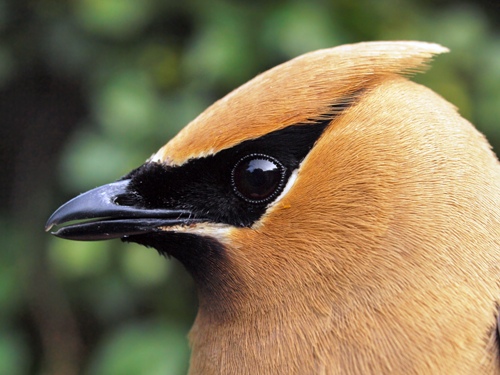
A nice facial profile of one of the 56 Cedar Waxwings banded this week.
(Photo by
Simon Duval) |
Our ninth fall season has just begun! We have another 12 exciting weeks ahead, and look forward to sharing our results as the season progresses. Be sure to also check out our Facebook page for live updates and additional photo highlights throughout the season.
|
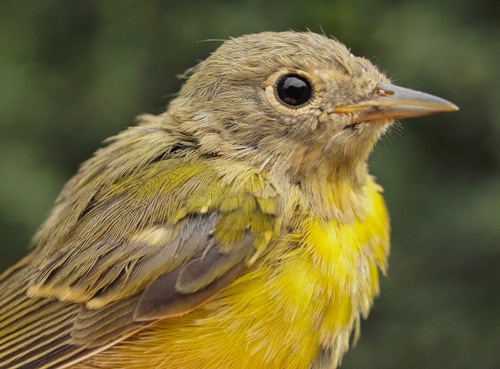
Nashville Warblers usually peak at MBO in September, after arriving from breeding grounds somewhere to the north. This very young-looking juvenile though suggests that at least one pair was breeding nearby this year, perhaps in the adjacent Morgan Arboretum.
(Photo by Simon Duval)
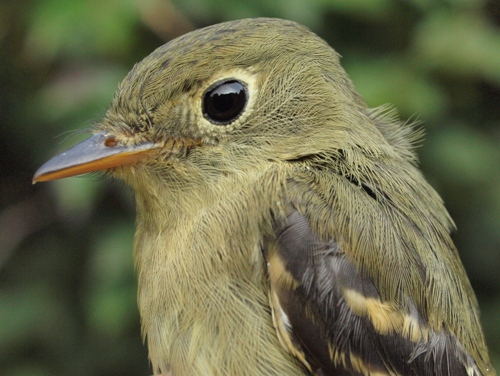
This Yellow-bellied Flycatcher was part of the first significant wave of "truly" boreal migrants that passed through MBO on August 6.
(Photo by Simon Duval)
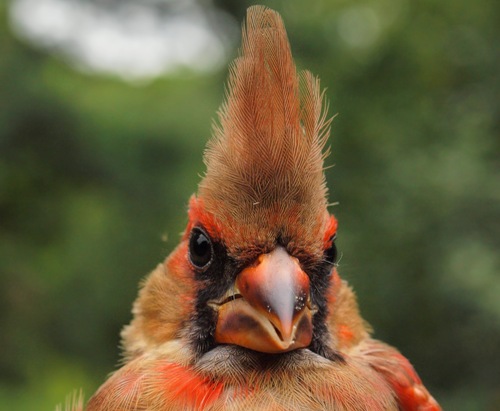
This juvenile male Northern Cardinal is already beginning to acquire some red plumage.
(Photo by
Simon Duval)
|







